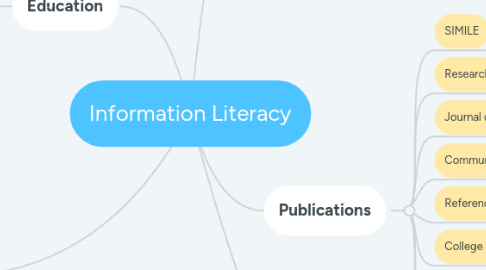
1. Roots
1.1. 1876: 1st ALA Conference: Melvin Dewey recognizes that libraries are a type of school and librarians are a sort of teacher
1.2. 1880's: 20 Institutions offering credit classes
1.2.1. Justin Winsor & Otis Robinson begin petitioning academic institutions to differentiate between "information" and "instruction"
2. Education
2.1. Primary and Secondary Education
2.1.1. 1918: School Libraries Established
2.1.2. 1938: Carter Alexander advises library instruction for different grade levels
2.1.2.1. Modern school library media specialists work with educators to plan, adopt & implement projects similar to what Carter Alexander envisioned.
2.2. Higher Education
2.2.1. 1960's: GI Bill expands educational opportunities to spark the modern day library instruction
2.2.2. 1989: Patricia Breivik conventionalizes the concepts and goals of information literacy for instruction librarians through the ALA Presidential Committee on Information Literacy
2.2.3. 1990: Martin Raish establishes the Bibliographic Instruction Listserv for all librarians interested in instruction
3. Modern
3.1. Bibliography Instruction
3.1.1. 1964: F2F Group Instruction (synchronous)
3.1.2. Self-Paced Workshops (Asynchronous)
3.2. Information Competency & Information Fluency
3.2.1. 1994: Maricopa County Community College: Ocotillo Report
3.2.2. 1998: Wisconsin Association of Academic Librarians develop an Information Literacy Competency list and criteria for stat academic libraries
3.2.2.1. 2000: State University of New York adopted similar measures
3.2.3. 1995: California State University system developed major information competency initiative that integrates Information literacy into the curricula of all 23 campuses
3.2.3.1. 1998: California community college libraries engage in stateside implementation, training and evaluation
3.2.4. 1999: U.S. National Academy of the Sciences Introduces Fluency with Information Technology or FITness
4. Publications
4.1. SIMILE
4.2. Research Strategies
4.3. Journal of Information Literacy
4.4. Communications in Information Literacy
4.5. Reference Services Review
4.6. College & Research Libraries
4.7. Journal of Academic Librarianship
4.8. portal: Libraries and the Academy
4.9. Evidence-based Library and Information Practice
5. Groups
5.1. Patricia Breivik ALA Presidential Committee on Information Literacy
5.1.1. Big 6 Skills (k-12)
5.1.1.1. ALA AASL
5.1.2. ACRL (higher education)
5.2. Regional Organizations
5.3. Library Orientation & EXchange
5.4. ALA ACRL BI Instruction S/Instruciton Section
5.4.1. ALA Library Instruction Roundtable
5.4.1.1. 1975: Miriam Dudley established
5.4.1.1.1. Bibliographic Instruction Section (BIS)
5.4.1.1.2. ALA Library Instruction Round Table (LIRT)
5.4.1.1.3. California Clearinghouse on Library Instruction (CCLI)
5.4.1.2. ACRL & Broader Information Literacy Initiatives
5.4.1.2.1. International Federation of Library Associations (IFLA)

